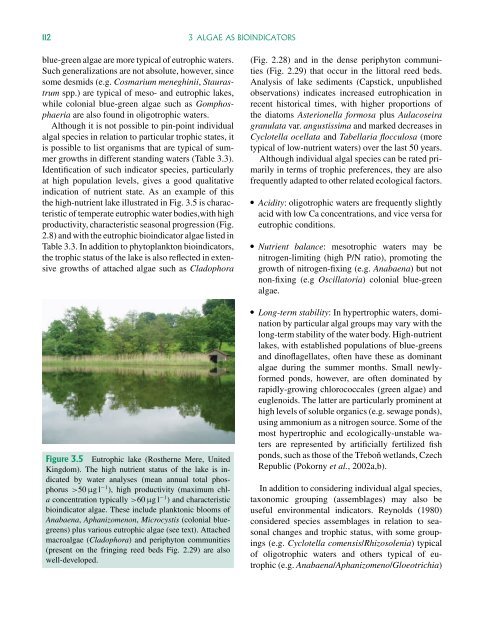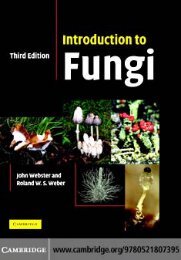Freshwater Algae: Identification and Use as Bioindicators
Freshwater Algae: Identification and Use as Bioindicators
Freshwater Algae: Identification and Use as Bioindicators
Create successful ePaper yourself
Turn your PDF publications into a flip-book with our unique Google optimized e-Paper software.
112 3 ALGAE AS BIOINDICATORSblue-green algae are more typical of eutrophic waters.Such generalizations are not absolute, however, sincesome desmids (e.g. Cosmarium meneghinii, Staur<strong>as</strong>trumspp.) are typical of meso- <strong>and</strong> eutrophic lakes,while colonial blue-green algae such <strong>as</strong> Gomphosphaeriaare also found in oligotrophic waters.Although it is not possible to pin-point individualalgal species in relation to particular trophic states, itis possible to list organisms that are typical of summergrowths in different st<strong>and</strong>ing waters (Table 3.3).<strong>Identification</strong> of such indicator species, particularlyat high population levels, gives a good qualitativeindication of nutrient state. As an example of thisthe high-nutrient lake illustrated in Fig. 3.5 is characteristicof temperate eutrophic water bodies,with highproductivity, characteristic se<strong>as</strong>onal progression (Fig.2.8) <strong>and</strong> with the eutrophic bioindicator algae listed inTable 3.3. In addition to phytoplankton bioindicators,the trophic status of the lake is also reflected in extensivegrowths of attached algae such <strong>as</strong> CladophoraFigure 3.5 Eutrophic lake (Rostherne Mere, UnitedKingdom). The high nutrient status of the lake is indicatedby water analyses (mean annual total phosphorus>50 µgl −1 ), high productivity (maximum chlaconcentration typically >60 µgl −1 ) <strong>and</strong> characteristicbioindicator algae. These include planktonic blooms ofAnabaena, Aphanizomenon, Microcystis (colonial bluegreens)plus various eutrophic algae (see text). Attachedmacroalgae (Cladophora) <strong>and</strong> periphyton communities(present on the fringing reed beds Fig. 2.29) are alsowell-developed.(Fig. 2.28) <strong>and</strong> in the dense periphyton communities(Fig. 2.29) that occur in the littoral reed beds.Analysis of lake sediments (Capstick, unpublishedobservations) indicates incre<strong>as</strong>ed eutrophication inrecent historical times, with higher proportions ofthe diatoms Asterionella formosa plus Aulacoseiragranulata var. angustissima <strong>and</strong> marked decre<strong>as</strong>es inCyclotella ocellata <strong>and</strong> Tabellaria flocculosa (moretypical of low-nutrient waters) over the l<strong>as</strong>t 50 years.Although individual algal species can be rated primarilyin terms of trophic preferences, they are alsofrequently adapted to other related ecological factors. Acidity: oligotrophic waters are frequently slightlyacid with low Ca concentrations, <strong>and</strong> vice versa foreutrophic conditions. Nutrient balance: mesotrophic waters may benitrogen-limiting (high P/N ratio), promoting thegrowth of nitrogen-fixing (e.g. Anabaena) but notnon-fixing (e.g Oscillatoria) colonial blue-greenalgae. Long-term stability: In hypertrophic waters, dominationby particular algal groups may vary with thelong-term stability of the water body. High-nutrientlakes, with established populations of blue-greens<strong>and</strong> dinoflagellates, often have these <strong>as</strong> dominantalgae during the summer months. Small newlyformedponds, however, are often dominated byrapidly-growing chlorococcales (green algae) <strong>and</strong>euglenoids. The latter are particularly prominent athigh levels of soluble organics (e.g. sewage ponds),using ammonium <strong>as</strong> a nitrogen source. Some of themost hypertrophic <strong>and</strong> ecologically-unstable watersare represented by artificially fertilized fishponds, such <strong>as</strong> those of the Třeboň wetl<strong>and</strong>s, CzechRepublic (Pokorny et al., 2002a,b).In addition to considering individual algal species,taxonomic grouping (<strong>as</strong>semblages) may also beuseful environmental indicators. Reynolds (1980)considered species <strong>as</strong>semblages in relation to se<strong>as</strong>onalchanges <strong>and</strong> trophic status, with some groupings(e.g. Cyclotella comensis/Rhizosolenia) typicalof oligotrophic waters <strong>and</strong> others typical of eutrophic(e.g. Anabaena/Aphanizomeno/Gloeotrichia)
















